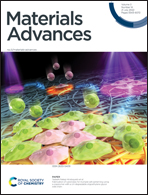Effects of a polystyrene intermediate layer for improved electrochromic properties of nano porous WO3 electrochromic films
Abstract
Nanostructured electrochromic materials having long life cycle and high chemical stability are promising for displays, rear view mirrors, and smart window applications. In the present study, nano tungsten trioxide (WO3) films are prepared using a low-cost conventional spin coating method. The porosity of the WO3 layers is developed using a polystyrene intermediate layer in order to improve the cyclic stability of the film. The structural characterization using X-ray diffraction confirms the formation of the orthorhombic phase. Surface studies via atomic force microscopy and scanning electron microscopy show a porous network along with a change in the roughness of the films. Electrochromic study using a potentiostat, UV-visible spectrophotometer and the voltammetry method indicate that a porous crystalline WO3 has a stable coloration efficiency, durability, and fast response to the electrochromic cycle with higher transmittance in comparison with nonporous WO3 films. The crystalline film with a porous structure shows a transmission modulation of about 65.3% and 10% more coloration efficiency than the nonporous film. The electrochromic properties of the crystalline nonporous film deteriorate at/after 500 °C. The porous structure improves the chemical stability of the film with long durability and solves the problem of degradation of the film after long hours of operation for an electrochromic device.

- This article is part of the themed collection: Shaping the Future Using Thin Films and Nanotechnology


 Please wait while we load your content...
Please wait while we load your content...